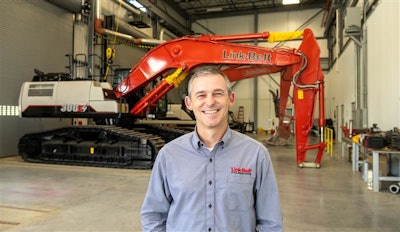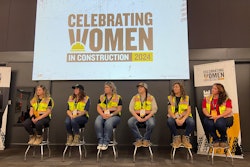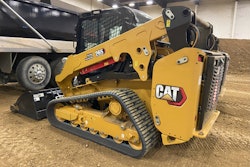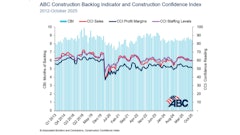
Another year has ended, and we have welcomed a new one. In 2023, the industry saw many successes and faced many challenges. Among the major challenges has been the labor shortage, which is likely to continue into the New year. Wilfried AulburRoland Berger
Wilfried AulburRoland Berger
According to Associated Builders and Contractors (ABC), “The construction industry had 423,000 job openings on the last day of October [2023], [based on] an ABC analysis of data from the U.S. Bureau of Labor Statistics’ Job Openings and Labor Turnover Survey (JOLTS). JOLTS defines a job opening as any unfilled position for which an employer is actively recruiting. Industry job openings decreased by 4,000 in October but are up by 25,000 from the same time last year.”
In addition to the labor shortage, another trend from 2023 that will continue into 2024 is the push to decrease emissions. While diesel remains the primary power source for construction equipment, the research of and move to other sources, including alternative fuels and hydrogen, will not stop. According to a recent McKinsey article about the Conference of the Parties (COP28), “the search for sustainable, reliable and affordable energy will be at the core of global aspirations.” The construction industry’s massive equipment is a contributor to carbon dioxide, and engine and iron manufacturers are striving to help contractors decrease their emissions. Herwig PeschlCaterpillar
Herwig PeschlCaterpillar
To learn more about these challenges and what the industry can expect in 2024, the Equipment Today team talked with several industry experts to get their insights into the state of the construction industry.
2023 Challenges
As mentioned, the biggest challenge, according to the thought leaders interviewed, was the labor shortage. The industry came together in October during the Ariat Dirt World Summit to discuss the workforce shortage and ways to recruit and retain talent. Among many of these are training, making the industry appealing to the next generation and promoting the industry.
“We’ve … developed programs to promote this profession, including Caterpillar’s Global Operator Challenge,” said Herwig Peschl, senior vice president, global construction & infrastructure, for Caterpillar. “More than 10,000 operators worldwide signed up to compete in local events organized by Cat Dealers which culminated with Caterpillar crowning a champion at the finals in Las Vegas at CONEXPO/CON-AGG in March 2023.”
Read the full exclusive interview from Caterpillar's Peschl.
As will be the case moving into 2024, technology is helping bridge the gap of the workforce shortage.
“With low unemployment plus inflation, everyone looked to technology to help bridge that gap by making employees more productive to help drive profitability,” said Mike Gidaspow, vice president of products, service and solutions, Komatsu. “The saying that ‘necessity is the mother of invention’ certainly holds true as we continue to develop machines and technology that enable contractors to be as efficient as possible.”
Read the full exclusive interview from Komatsu's Gidaspow.
 Mike GidaspowKomatsu
Mike GidaspowKomatsu
Read the full exclusive interview from Bobcat's Delahoyde.
Another challenge that continued in 2023 was supply chain disruptions. “The supply chain remained an area of concern, especially for the first half of the year. While the overall situation improved, for example, on semiconductors, shortages remained and had an impact on the supply chain, which propagated into manufacturing,” said Wilfried Aulbur, senior partner with Roland Berger.
Read the full exclusive interview from Roland Berger's Aulbur.
Jacob Sherman, product and dealer marketing manager, DEVELON North America also stated that the biggest challenge in his mind was the supply chain.
“Supply and demand were the construction industry’s biggest challenge in 2023,” he said. “But much of it seems to be a carryover from the pandemic. Many manufacturers have a positive outlook for 2024 and are optimistic about a strong year in construction equipment sales and demand.”
Read the full exclusive interview from DEVELON's Sherman.
 Ryan DelahoydeBobcat
Ryan DelahoydeBobcat
Read the full exclusive interview from Link-Belt Excavator's experts.
The 2024 Workforce
As workers retire, new talent must be recruited, and the construction industry still needs personnel moving into 2024. What are some ways that companies are attracting and retaining new talent?
“To attract, train and retain the staff we need, we are taking steps to help alleviate [the labor shortage exacerbated by the pandemic] by initiating an apprenticeship program that is similar to that in Europe,” said Gert Reichetseder, president and CEO, Wacker Neuson Americas. “This will help us expand and strengthen our factory team to support our continued growth, as we believe not only in hiring talent but developing and training our Wacker Neuson employees ourselves.”
Read the full exclusive interview from Wacker Neuson's Reichetseder.
 Jacob ShermanDEVELON
Jacob ShermanDEVELON
Read the full exclusive interview from Manitou's Nartish.
One way that the construction industry has been combatting the workforce shortage is with technology. With innovations like grade control, telematics and automation, personnel. During 2024, experts predict that these will continue to be used and innovated.
“That challenge has really driven the solutions we’re bringing to market. [During] the [last] year, we rolled out an unprecedented number of new machines—more than 30 in all—directed at helping contractors of all sizes get more work done easier and more profitably than ever before,” Terry Dolan, vice president, CASE Construction Equipment, North America, said. “Whether it’s incorporating more intuitive electrohydraulic controls in dozers to minimize the operator’s learning curve or now offering new, subcompact machine markets to give small contractors construction-grade options for getting more done with fewer people, we’re innovating to meet customers where they are today so they can overcome those labor challenges.”
Read the full exclusive interview with Case Construction Equipment's Dolan.
 Chris WiseLink-Belt Excavators
Chris WiseLink-Belt Excavators
“Younger workers entering jobs in construction are digital natives,” Elwyn McLachlan, sector vice president for Trimble Civil Solutions, said. “They know their way around gaming consoles, touchscreens and apps, which makes their adoption of construction technology easy. Many of our customers tell us that young workers are seeking jobs with companies that are on the forefront of technology adoption, and that investing in technology like machine control and connected construction workflows provides a competitive advantage when it comes to hiring.
Read the full exclusive interview from Trimble Civil Solutions' McLachlan.
These innovations will also require that new and existing employees receive the training needed for today and the future.
 Gert ReichetsederWacker Neuson
Gert ReichetsederWacker Neuson
Emission Regulations & Power Options
In the U.S., the Environmental Protection Agency continues to strengthen the regulations for decreased emissions from off-highway equipment. Because of these EPA adjustments, the construction industry is under increased pressure to ensure that its machines are optimized and continuously improved to lower engine emissions.
In addition to the optimization of diesel engines, the industry has been making the move to alternative power, including:
- Battery electric
- Hydrogen combustion engines
- Hydrogen fuel cells
- Hydrotreated vegetable oil (HVO)/renewable biodiesel
- Biodiesel
- Natural gas
 Ilmars NartishManitou
Ilmars NartishManitou
In addition to decreased emissions, electric machines provide quieter operation. This is particularly important in residential and urban locations.
Many of the experts we spoke with say their companies are moving to battery electric equipment, including some medium-sized models.
“Electrification is another area where we are seeing rapid advancement and innovation. The technology is finally at the point where we can deliver the power, battery range and charge times needed to make electric vehicles (EVs) an attractive option for some contractors,” Dolan said. “CASE is launching a variety of new EV models—including the next iteration of the industry’s first fully electric backhoe—that offer the same, if not more, power and performance as their diesel counterparts.”
Caterpillar is also making strategic investments around electrification and alternative fuels.
 Terry DolanCASE Construction Equipment
Terry DolanCASE Construction Equipment
Jobsite tools are also making the move to battery-electric power. They remove wires, prevent fuel leakage and provide quieter operation.
“Milwaukee Tool is fully dedicated to continuing to drive this industry transition,” said Christian Coulis, senior vice president of product management with Milwaukee Tool. “We have dedicated research and development teams to understand and deliver alternative power on the jobsite. For example, our new MX FUEL REDLITHIUM FORGE Battery Packs provide more power to the equipment and have longer runtimes and faster charging capabilities to stay efficient on the job.”
Read the full exclusive interview with Milwaukee Tool's Coulis.
Several roadblocks are preventing the widespread adoption of alternative power. Among them is the lack of infrastructure for fueling.
 Elwyn McLachlanTrimble
Elwyn McLachlanTrimble
Read the full exclusive interview from The Associated General Contractors of America's Simonson.
Another challenge to alternative power is the familiarity of contractors and operators with diesel fuel and the fuel’s easy availability.
“Unless there is a disruption in the flow of diesel fuel in North America, contractors may be reluctant to try electric- or hydrogen-powered equipment, especially if it brings a bigger price tag,” Sherman said.
Manufacturers are working to mitigate these roadblocks in many ways, including providing mobile charging and refueling solutions.
“You can technically run the equipment for, give or take, about one working day, but what's next? How do you charge? How do you address the need for the power?” Nartish asked. “Those are major considerations that sometimes get glossed over in the electrification conversation. As such, we are one of the few manufacturers addressing the subject by offering range extenders with our electrified machines. These range extenders include a small generator that allows the equipment to recharge itself during use.
Technology Innovations
When we spoke with the experts, they indicated several areas of innovation moving into the New Year in addition to expanding power sources to drive equipment including:
- Automation
- Machine control and guidance
- Grade control
- Telematics
- Artificial intelligence (AI)
- Robotics
- Safety systems
- The Internet of Things (IoT) (covered in another section)
All these areas are expected to grow and improve the industry in 2024.
 Christian CoulisMilwaukee Tool
Christian CoulisMilwaukee Tool
Automating time-consuming, multi-person tasks is another innovation that will become more popular in 2024.
“The Pro Trailer Hitch Assist, which can be operated by pushing and holding a button while monitoring progress on the truck’s large center screen display, simplifies what was traditionally a two-person job into a more manageable single-person task,” said Kevin Lieberum, commercial truck brand manager for Ford Pro.
“… Another significant advancement is in the realm of machine learning with driver-assist technology, particularly with the introduction of the smart hitch and Pro Trailer Hitch Assist,” he continued. “This feature employs advanced machine learning technology to detect the hitch ball, trailer and coupler at distances of up to … 20 feet. The system aligns the hitch with the trailer coupler using the rear camera and corner radars, simultaneously controlling the truck’s speed, steering and braking to ensure precision. Ultrasonic parking sensors detect any obstacles in the truck's path, enhancing safety during the hitching process.”
Read the full exclusive interview from Ford Pro's Lieberum.
 Kenneth SimonsonThe Associated General Contractors of America
Kenneth SimonsonThe Associated General Contractors of America
“John Deere has started offering advanced vision systems with 360-degree views around the machine,” Jon Gilbeck, manager, customer success and technology sales, John Deere, said. “Additionally, our SmartDetect system uses stereo camera technology, machine learning and artificial intelligence to specifically identify people and other objects on jobsites.”
Read the full exclusive interview from John Deere's Gilbeck.
Technology and software can also help contractors select the right attachments for their equipment. According to Mike Kucharski, VP of sales, marketing, & IT, IronCraft.
“At IronCraft we recognize that being easy to buy and easy to own is a critical customer requirement. Recently, we … launched two initiatives that will continue to evolve and grow through 2024, he said. “[The website] myequipmentspecs.com and QR codes link back to online service manuals and our new parts store. Myequipmentspecs.com will enable anyone to quickly look up specs for their tractor, skid steer or excavator and provide them with resources to get more out of the equipment that they already own. These solutions should help our industry be more informed to make good, quick decisions on the compatibility … machine and maintenance parts for their IronCraft attachments.”
Read the full exclusive interview from IronCraft's Kucharski.
IoT & Connectivity
 Kevin LieberumFord Pro
Kevin LieberumFord Pro
According to Aulbur, some examples include:
- Investments that John Deere made in this area
- CNH’s acquisition of Raven
- AGCO with its acquisition of Trimble’s agricultural business
IoT, including cloud storage, has simplified and decreased the cost of sensors and other data collection. It has led the way for the connected jobsite, allowing contractors and manufacturers and dealers to access equipment data to improve reliability, safety and operating efficiency.
“The biggest technological innovation we will see … more of in 2024 is smart, connected jobsites—everything from the initial utility locating to final reporting,” said Kevin Smith, general manager, Ditch Witch. “Advancements in locating technology allow crews to collect data on utilities and the underground environment while they prepare for an underground construction job. Technicians can map and label identified utilities in real time and then upload the information to a mapping service.”
Read the full exclusive interview from Ditch Witch's Smith.
 Mike KucharskiIronCraft
Mike KucharskiIronCraft
“As a complimentary offering, Telematics Essentials provides crucial vehicle health data such as odometer readings, diagnostic trouble codes, oil life, engine hours and recall information for Ford vehicles,” Lieberum said. “This service allows fleets to track and plan maintenance or repair services with local dealers, transforming fleet health and maintenance into actionable insights.”
To allow for the use of many construction technologies, connectivity is critical.
“From enabling machine control, to connecting stakeholders across the construction continuum, to helping project owners more effectively operate and maintain their finished assets, software is transforming the construction industry,” McLachlan said. “The ability to connect people, projects and machines and then use the data from those systems to make better business decisions offers unmatched potential for everyone in the construction lifecycle.”
Overall, jobsite efficiency is a result of connectivity, according to
“We predict an increase in efficiency on all job sites [because of] these technological advancements throughout the industry,” Friedrich. “Liebherr’s offerings include technological innovations within our machines enabling our customers with faster and more efficient troubleshooting, preventive machine maintenance, fewer accidents, and more precise operation.”
Caterpillar’s technology assists its users, too.
 Kevin SmithDitch Witch
Kevin SmithDitch Witch
With smartphones in everyone’s pocket, construction contractors and operators expect data that they need to be available in real time. According to Gidaspow, this is true for parts ordering and equipment information.
“Our customers expect the information that they need to be more productive at their fingertips—whether on their phone, tablet or laptop. All of us have become very accustomed to ordering something one day, and having it delivered in a day or two. Our customers expect that experience to be replicated which is why we have made parts ordering easier through My Komatsu.
“There are also challenges because increased collaboration involves interacting with complex systems and more stakeholders,” he continued. “Our vision is to improve operations across all steps of the construction process.
That is why technology needs to be brand-agnostic so that we can help our customers with their entire fleet. IoT helps us develop technology that is brand-agnostic, which is a real boon for our customers.”
Infrastructure Funding From the IIJA
The bipartisan Infrastructure and Jobs Act (IIJA) provides funding for public works projects including roads, bridges, water and wastewater treatment plants and rail networks.
 Jon GilbeckJohn Deere
Jon GilbeckJohn Deere
The continual increases in projects will gain speed during the New Year, according to Reichetseder. “Infrastructure spending generated by the IIJA will continue to be a key driver of construction industry growth in most regions across the U.S., especially as the number of projects and spending generated by the bill gains much more momentum heading into 2024 and 2025,” he said. “This increase in spending and construction projects will result in an increased demand for construction equipment, expanding our opportunities in the marketplace.”
The potential problem with all this spending according to Dolan with CASE is whether we will have the workforce to carry out the projects and how technology and improved equipment can help with that.
“With $1.2 trillion of U.S. federal money earmarked, we’re on the cusp of the biggest government investment in infrastructure construction and repair since the building of the interstate highway system in 1956. This is a once-in-a-generation opportunity for contractors who will reap benefits for years to come,” Dolan said. “… Over the next decade, a huge portion of the construction workforce is expected to retire. That means contractors will need new ways to meet demand with the challenge of a diminishing workforce. To take advantage of the coming investment, they’ll need ways to do more work with less. The industry is positioned to evolve. That’s why CASE has expanded and enhanced our product offering to ensure that contractors have the right machine with the right attachments at the right time.”
Fortunately for the country’s economy, the construction industry is not the only beneficiary.
“Not only does the construction industry benefit from infrastructure investments, but the overhaul of our infrastructure also benefits logistics and other industries, reducing costs and improving turnaround times,” Aulbur said.
2024 Challenges
As detailed earlier, the labor shortage in the construction industry will continue to be a hurdle into the New Year. Another difficult factor that the industry faces in 2024 is the requirement to move to zero emissions.
“Demand for green products is huge for all original equipment manufacturers to meet these evolving requirements,” said Kai Friedrich, managing director and divisional director of earthmoving and material handling technology for Liebherr USA, Co. “Each of our supply and technical innovations is still being refined to meet the expectations of our customers. We are very close to fulfilling these needs, but it will take some more time.”
Read the full exclusive interview from Liebherr's Friedrich.
According to McLachlan, technology can help contractors measure emissions and make their equipment more efficient, decreasing emissions.
“As we move into 2024, environmental sustainability will continue to be an important topic for the construction industry,” she said. “In most cases, current construction processes still produce too much waste and [have an] environmental impact, both in the construction phase and once an asset is complete and moves into the operations phase. We know that technology can deliver measurable sustainability benefits, including a reduction in fuel consumption, carbon emissions and wasted materials.”
Along with the move toward zero emissions is the need to manage fleets operating on fuel sources. This includes maintaining the equipment, refueling or recharging, and efficient and optimized operation.
“… Fleet managers will need to operate traditional gas [or diesel] vehicles and EVs in one fleet. This shift necessitates a reevaluation of fleet management strategies to accommodate the differing needs of [traditional fuel] and EVs, particularly in terms of maintenance, charging and overall fleet operation,” Lieberum said. “Ford Pro is positioned as a comprehensive solution to this challenge, offering a suite of services that cater to the needs of mixed fleets.
“Our Ford Pro solutions combine advanced software, charging options, service and financing for commercial vehicles into one integrated platform. This unified approach is designed to assist businesses as they navigate the complexities of adopting connected and electrified vehicles across their operations.”
The U.S. economy may also cause upheavals for contractors and manufacturers according to some experts.
“In an economy with sales channels and original equipment manufacturers filled with equipment and unfavorable foreign trade conditions throughout 2024, turning existing inventory will be an ongoing challenge,” Reichetseder said. “The bottlenecks and supply availability caused by the pandemic exposed many areas of weakness in the supply chain, including timely procurement for deliveries and efficient warehouse management. Improvement in these areas will be key factors in increasing productivity and driving down lead times to help return equipment availability to normal levels.”
Part of the economic difficulties is the high interest rates that the U.S. is experiencing.
“Interest rates are at an all-time high, having a significant impact as the cost of funds goes through the roof. It [has] a significant impact on the industry because anything you build today is going to cost a lot more than it did a year ago,” Nartish said. “Certainly, I understand everybody has in their mind to ease the inflation, but ultimately the high interest rates will continue to drive costs upward for all of the companies … operating in this space.”
However, Aulbur does not expect the economy to be a major problem.
“We will see a cooling in demand after some stellar years, which will lead to some adjustments in the industry,” he said. “Yet, the economy remains strong, and 2024 should be a good year for the construction industry.”




















